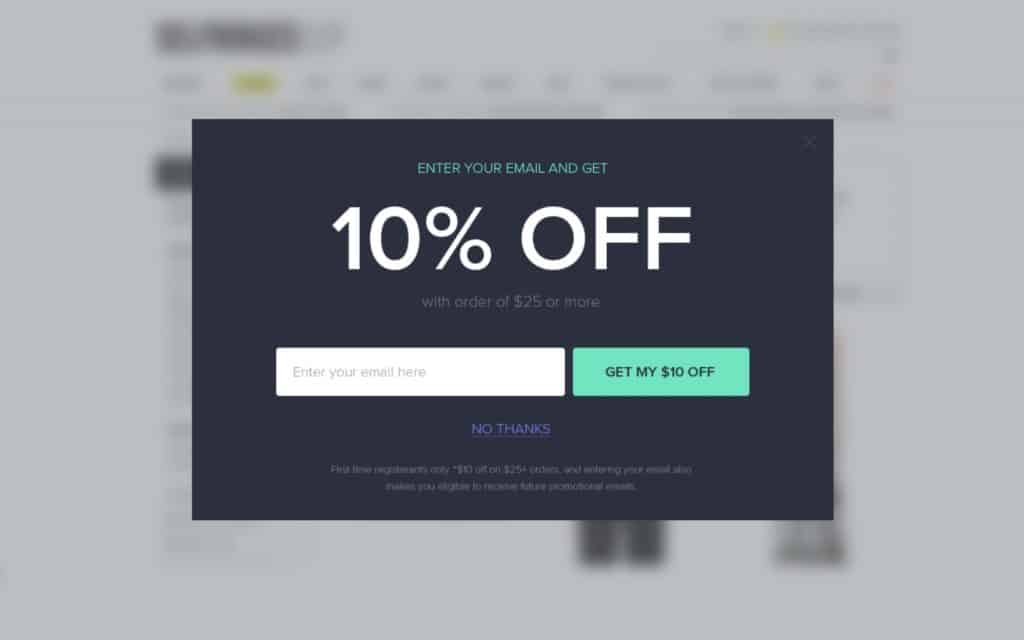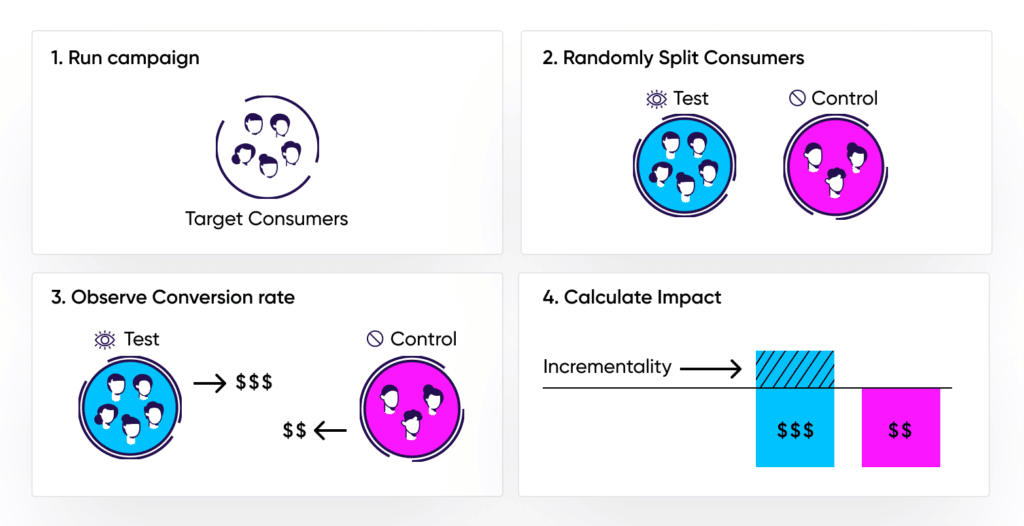
If you’re curious about incrementality (or maybe even tired of hearing about it), we can’t blame you. The term has been thrown around for years by digital marketers; it’s been a consistent topic when brands hit a certain point in scaling their performance efforts or consider opening a new channel like partnerships. But what is incrementality, and why should brands care about it?
On one hand, you can make the case that a net-new channel to the business is largely incremental, since it’s a new traffic source. On the other, it’s a specific approach to measuring control and lift down to individual ad rotations. In my experience, incrementality has taken many forms and can’t be discussed without recognizing the cross-channel impact all marketing efforts contribute to the equation. Did your SEM campaigns or cobranded content influence the conversion? Or was it that lightbox that popped up when the customer was inactive for a few seconds on their cart page? Did they get an email yesterday with a catalog of new products, or was it a display ad that was served while they were catching up on the news? Do they follow an influencer who happened to talk about a similar product?
It’s necessary to define any success metrics before spending time, capital, and resources executing a new campaign or gathering various data points. Below, I’ll share my perspectives on where incrementality sits in the priority list and why it doesn’t always have to be a critical success metric.
What Is Incrementality?
Since the beginning, multiple attribution methods have been commonplace in performance channels. As the digital industry and brands have evolved, so has the need for a different way to think about the effectiveness of paid campaigns. This is where incremental gains have become a hot topic: Can I really see if I’m getting the same customers, higher conversion rates, increased AOV, or any other important metric without this additional touchpoint in the broader funnel?
So, what is incrementality anyway? You’ll find answers in many forms, but here’s a good summary from AdRoll to get you started. In short, incrementality measures whether a specific touchpoint or engagement pushed a customer to convert, when otherwise that conversion would not have happened without it.
In the affiliate and partner marketing space, it’s common to hear the term when talking about increasing commissions to publishers, discounting to customers, or launching a new extension partner to see if the changes make an incremental impact on a brand’s programs. But in its true form, incremental value can only be determined by a comprehensive lift analysis, with control groups and multi-variate factors in play. And this isn’t the same as a single-channel A/B split test – we’re talking a full-funnel, cross-channel deep dive on all touch points – essentially all at the same time.
What Does Incrementality Look Like?
The short answer is, there is no right answer. Incrementality comes in all shapes and sizes. How it looks to you will be different than how it looks to me, based on our businesses, needs, goals, and various other factors. But that’s not very helpful when you’re trying to learn, so here are a couple example scenarios:

Example 1: A customer is shopping online for a new vacuum, but they haven’t decided to purchase during that browser session yet. Then, a lightbox pops up to offer a 10% discount on first time purchases if the customer signs up for an email newsletter. The customer decides that’s the tipping point, and they end up buying the vacuum in the same session.
Example 2: A finance brand is generating qualified leads from the same partner, but they want to see if they can increase their account sign-up conversion rate. They split their audience in half for two days, serve one group the standard landing page and sign-up flow, and serve the other group the same landing page and flow but with a 5% bonus added to their account if they register in the same session.
Two similar but different approaches to what incremental growth can look like. These aren’t the most complex situations, but if you pull back and think about how many emails the customer received in the last few days, whether they saw other branding or content before choosing to shop, or simply the unknown variables, this becomes a bigger quest.
Now, if we look at incrementality through the lens of a specific affiliate marketing scenario, it may look something like this:
- Sample 1: group of customers who do not see an offer via their browser extension when at checkout
- Sample 2: group of customers who do see an offer via their browser extension
- Goal: Did the output from each group convert at the same, lower, or higher rate? What was the delta between the two groups? Did offering an incentive make a meaningful difference?
In principle, brands are trying to understand the effectiveness of their campaigns (largely paid efforts), unlock data to get more efficient with their ROAS (return on ad spend), and better optimize the customer experience. Who can argue with the value of more consumer insights to optimize the customer experience and increase market penetration? Still, I have seen on many occasions the quest for incrementality lead to convoluted scenarios, unclear results, and stressed-out program managers.
Why Incrementality Is Hard to Get “Right”
Incrementality is subjective, almost to a fault. Its definition and value are going to sound different based on who you ask and which data points matter to your company the most. A direct-to-consumer e-commerce brand will have different success goals than an insurance brand looking to generate leads. A fintech startup is going to need a very different strategy than a mature enterprise retailer.
I’m not suggesting you look at incrementality as a fool’s errand, not by any means – I’m actually a big fan of the tasks required to get this information, and I’ve seen how some businesses can leverage pieces of insight for future optimization. For example: On the affiliate marketing side, there have always been questions about whether lower-funnel discount partners actually impact conversions. So, brands will sometimes pause those partners for a short time to see if their run rate drastically changes – or they will pull down any active offers from a partner to see if customers still convert at a similar rate. But I’ve also seen many groups get flustered and overrun with the reality of having so many moving pieces that it almost makes it more difficult to showcase value in the channel or campaign. Or cobble together a version of a lift analysis for the sake of showing incremental growth, but lacking any real depth or actionable insight.
I never wrapped my head around the mad dash to “prove” incrementality, and often within a short period. Working at an agency, this was a common theme I heard for justifying added costs: Prove to me you can get incremental results within 90 days, or we don’t believe in the affiliate channel. I can appreciate the level of urgency and risk the brand is taking, but unreasonable expectations and an ambiguous definition of success will simply be a waste of time and resources for all involved. I would frequently see how brands got more value in lowering their customer acquisition costs by negotiating better rates for media and exposure, or diversifying their partner mix to lower their effective CPA; maximizing their ROAS through a test-and-learn mentality by dipping their toes into a trademark plus campaign with a reputable partner, or reworking their syndicated content to reflect their brand’s evolution.
Again, these activities can arguably fall under the incremental camp, but depending on what the business case is, they can also get lost in the shuffle of what we perceive that term to mean. Partnerships is one of those ecosystems that thrives on both direct, one-to-one co-branded experiences as well as a broader branding approach to educate consumers in an effort to build loyalty and trust over time. It’s what makes the concept of incrementality exciting but challenging to get right. As with any data you collect, it’s more important to understand what to do with it and how to leverage what you have for a better strategy in the future.
How to Think About Incrementality as a Business
Many brands seek “true incrementality” validation with investment in affiliates, an agency, or new technology, or just for specific paid media they are hesitant to invest in. I always enjoyed getting this question of how to think about incrementality, because it’s an opportunity to better understand how each group defines the term and what they look to gain from that insight. It’s a great way to learn new perspectives and share different points of view.

A full cross-channel approach is one way to think about it. A controlled cohort test in one channel is another. And everything in between. There are variables that will change the desired outcome, including shifts in the economy, consumer evolution, and disruptive brands coming into the market, so first and foremost, keep that in mind as you evaluate results.
There’s no one-size-fits-all approach to incrementality. First, define which metrics are most important to the business overall. Then review each channel individually and address inefficiencies. For example, for the partnerships channel, you can ask, “Am I paying a partner too much commission based on the value of the customers they’re sending?” You can look at lifetime value or churn rates to start, and revisit that structure directly with your publisher so both parties can benefit. Or, “Am I spending too much on Facebook ads?” Take a percentage of that spend to test with micro-influencers to see if that changes things. Direct response is ideal for many brands, but the effect that social proof and branding can have over time creates an inertia that’s hard to find in other channels if done properly.
In Conclusion
At its core, incremental value can be a massive undertaking – depending on how you look at the situation. Don’t stop or get discouraged. Instead, set realistic expectations and take a bite-sized approach to understanding your audience before making any sweeping changes. Iterate on what’s working, and leave what isn’t on the back burner to reconfigure as needed.
Don’t get hung up on incrementality as your primary metric or spend too many cycles trying to perfect it. You can determine the success of your business based on several factors, and this is simply one of them. That doesn’t mean getting more incremental data is a bad idea, nor should brands ignore its value in the mix. But a blanket approach or definition of the term for all brands isn’t the right way to approach it.
My best advice is to adopt a test-and-learn mentality and gather more data on your customers to use across all your media efforts. Use control groups in select channels while offering different calls-to-action, offers, or products in others, and see if that yields any meaningful insight. At the end of the day, anything you do to lower your acquisition cost and increase engagement with your brand is a victory.
Questions? Comments? Feel free to reach out to me at [email protected].
Author
Matt Miltenberger is the Head of Sales for the East Coast region at TUNE. He has spent the last 10 years in the e-commerce and partnerships space, helping several enterprise-level and emerging businesses in the retail, health and wellness, fintech, travel, and mobile verticals accelerate their growth. He most recently spent nearly five years with a prominent partner marketing agency, and can often be found tinkering in the kitchen with new recipes.




Leave a Reply
You must be logged in to post a comment.